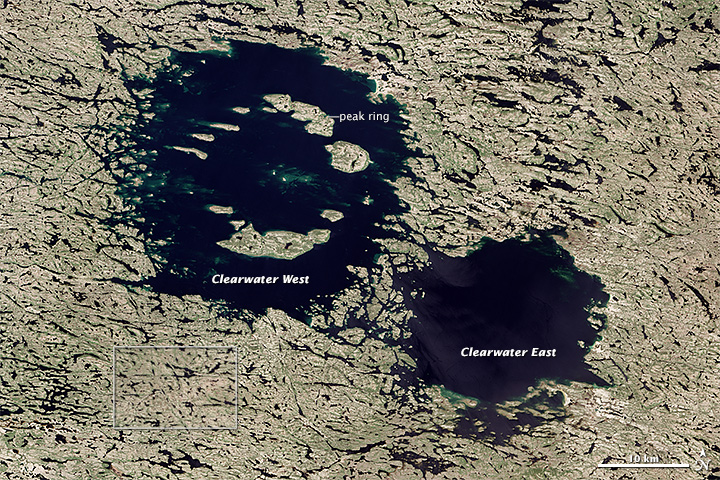Image: Clearwater Lakes 2013180 labels
Description: About 290 million years ago, two large asteroids smashed into Earth. The massive craters they left behind—now lakes—are still visible from space. Astronauts have noticed and photographed the craters for decades, and the Operational Land Imager on Landsat 8 captured a new image of Clearwater Lakes (Lac à l‘Eau Claire) on June 29, 2013. The small inset box toward the lower left marks the area shown in the lower image. When they struck, the binary asteroids crashed into a part of Earth’s crust that was fairly close to the equator. Since then, millions of years of plate tectonics have pushed the craters north into what is now northwestern Quebec. A mere 20,000 years ago (not long from a geologic perspective), massive sheets of ice covered northwestern Quebec, much like ice now covers Antarctica and Greenland. During that period, ice sheets repeatedly advanced and retreated, scouring the land of soil and rock during cool periods, and then carving deep channels and rinsing the landscape with melt water during warmer periods.
Title: Clearwater Lakes 2013180 labels
Credit: http://earthobservatory.nasa.gov/IOTD/view.php?id=82433
Author: NASA Earth Observatory images by Jesse Allen and Robert Simmon, using Landsat 8 data
Permission: Public domainPublic domainfalsefalse This file is in the public domain in the United States because it was solely created by NASA. NASA copyright policy states that "NASA material is not protected by copyright unless noted". (See Template:PD-USGov, NASA copyright policy page or JPL Image Use Policy.) Warnings: Use of NASA logos, insignia and emblems is restricted per U.S. law 14 CFR 1221. The NASA website hosts a large number of images from the Soviet/Russian space agency, and other non-American space agencies. These are not necessarily in the public domain. Materials based on Hubble Space Telescope data may be copyrighted if they are not explicitly produced by the STScI.[1] See also Template:PD-Hubble and Template:Cc-Hubble. The SOHO (ESA & NASA) joint project implies that all materials created by its probe are copyrighted and require permission for commercial non-educational use. [2] Images featured on the Astronomy Picture of the Day (APOD) web site may be copyrighted. [3] The National Space Science Data Center (NSSDC) site has been known to host copyrighted content. Its photo gallery FAQ states that all of the images in the photo gallery are in the public domain "Unless otherwise noted."
Usage Terms: Public domain
License: Public domain
Attribution Required?: No
Image usage
The following 3 pages link to this image:


